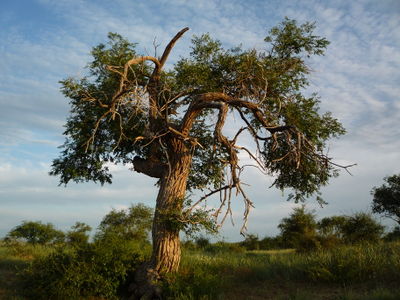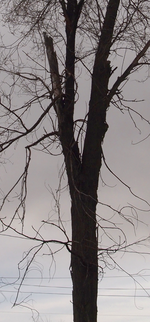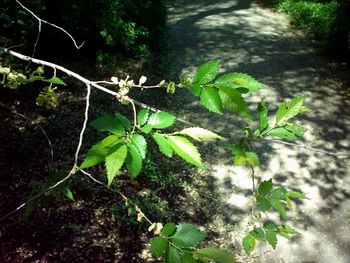User:Lyrithya/Siberian elm

Siberian elms are a weed. They also, as it happens, have relatively little to do with Siberia. Native to eastern Asia, where they tend to manage as small, sickly shrubs and trees, they have since been introduced to much of the rest of the world, including central and western North America, where they have thrived, taking on a new role as large, sickly shrubs and trees. There, they serve as either ornamental or as utter weeds, depending on whether or not the person you ask happens to have one growing on their property.
Though Siberian elms will take on a handsome and hearty appearance as saplings, they make for an impractical ornamental plant. Growing to decent size in a short time relative to many trees, they also die in a short time relative to many trees. While the exact manner in which they do this will vary, it usually involves significant pieces of themselves falling on the ground, garden, lawn, other trees, or house, often in a rain of leaves, snow, and/or squirrels. Other times, however, they will neglect to lose the dead pieces at all; many a tree will be seen not with a broken crown, but with simply a dead shaft sticking out part of the way up, peeling bark and thoroughly infested with squirrels.
Growth cycle[edit | edit source]
Even before they reach the point of dead top, Siberian elms will be rife with problems. Fungal infections are common, and a plague of insects is to be expected throughout the lifespan of the average tree, and this is on the off chance a tree in question manages to start growing properly in the first place, which most of them don't.
Mature Siberian elms, usually defined as those with at least one or two stems over a centimetre in diameter, manufacture a multitude of seeds in the early spring. These seeds start growing immediately, sometimes even before they hit the ground. Assuming they manage to find some patch of soil or soil-like substance, good year will yield up to two meters of growth, and this rate persists until they start dying. Those that land in soil usually remain healthy for about five to ten years, after which they start getting wider instead of taller and begin to accumulate fungal infections, but ones growing in other media can have much more varied reactions, from killing the host tree if they never actually entirely made it off the parent to trying to grow through a wall into a building, catching fire, and causing the entire thing to burn to the ground.
The squirrels usually start to set in around when large branches begin to die and start falling off, though not necessarily in the order.[1]
Eventually the entire thing topples. If the owner is lucky, the rest of the tree will die as well, but usually it takes more than that to effectively kill a Siberian elm, since the usual cycle involves the entire process beginning again with a mass of perfectly healthy new shoots emerging from the roots.
Pests[edit | edit source]
Besides being resilient pests themselves, pests to which Siberian elms are susceptible vary extensively, consisting of anything and everything native to a region and sometimes even inviting pests not native to the region to come on over anyway and hang out. Particularly hardy pests include bark mites, root mites, leaf mites and leaf beetles, as well as locusts, crickets, cicadas, fleas, and owls. Squirrels are common, and the odd horse has also been known to eat and/or get stuck in a Siberian elm. Fungal infections can range from that mildew growing in gran's bathroom to spot fungus and elm disease, though the latter two are less typical. Moss, ferns, and grass are particularly problematic for Siberian elms, as they make it that much easier for other Siberian elms to try to take root.
A Siberian elm's most potent enemy is probably gravity, however, as it is capable of taking down even the healthiest trees, and knows no regional boundaries.
Uses[edit | edit source]
For naïve landscapers unaware of the trees' sickly nature, Siberian elms have many uses - shade, groundcover, privacy screens, as well as the economical value of something that people will pay others to remove. For the less naïve, they can also serve for the odd prank, or even as a quick scam. To the average land owner, however, there is usually only one real use: firewood.[2] Even pruning older trees so they retain a somewhat healthy appearance will produce copious amounts of spare wood, and Siberian elm wood is much too brittle for use in construction.
Ornamental trees[edit | edit source]
Shrubbery[edit | edit source]
And hedges...
Pranks[edit | edit source]
They smell like chickens.
Firewood[edit | edit source]
Because Siberian elms only die in chunks and even at times have the consideration to drop their branches to attainable reach[3]
Removal[edit | edit source]
In theory, the best way to remove one of these trees would be to wait for it to die, light the stump on fire and then salt the surrounding ground. There is, unfortunately, one small snag, in that Siberian elms are quite terrible at the actual dying part. A good-sized tree will lose its top many times over the years; even if the entire terranean trunk perishes, the root systems are immense and will not hesitate to sprout new growth.
Notes[edit | edit source]
- ↑ Squirrels tend to make their homes in the larger ones. This only causes more of the tree to die, creating even more space for more squirrels.
- ↑ While branches falling on things could work well in demolition, predicting the growth and death of the trees has proven too difficult for it to serve any practical purpose.
- ↑ These branches, however, tend to still be alive when they do; the trees are not the best planners.



